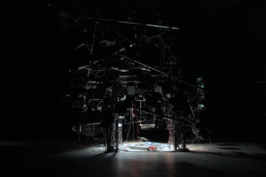BRUNO: Difference between revisions
No edit summary |
Revision as of 13:02, 27 March 2022
A piece by Alix Eynaudi / Lighting design Bruno Pocheron
Factual Description by Jan Maertens
Seated and waiting for the performance to start, i couldn't help to catch a glimpse of the gigantic LightMachine installed on stage and waiting for us in the semi-darkness. The house lights dim and it was by surprise that the stage got boldly lit by another light source than (from within) the LightMachine. A series of 3 consecutive prominent light ignitions from behind my back install a super bright white-light-to-become: we can undeniably recognise the ignition of gas lights units with their transitions over brief moments of an explicit underweight in other than some greenish and reddish parts of the visible spectrum. All this is leading to the establishment of a boldly angled and swiftly bright white overhead front light universe to a first part of the choreography with dancers nicely doubled out by their long and sharp shadows onto the white dance vinyl. No further light changes. The staged LightMachine stays idle, merely providing a (spatial) context for the choreography while casting its own shadow onto the back wall.
Black Out and more Silence. Ready for part 2? Not yet. First we have to sit out the silent black out. Re-calibration of the senses. Great!
Still in the dark, a sound scape, clearly coming from what-was-thought-to-be-a-LightMachine, establishes itself. A pipe orchestra reveals itself only in an audible way as if some one was playing the LightMachine as an organ. While the surrounding darkness invites us to imagine to play along with the many light fixtures of which the LightMachine is formed of. Or how total darkness doesn't mean at all the negation of visual information... (though I must admit that the one futil standby-LED of the emergency light was interfering a little with the full-on experience:-(
Light Out and ready for part 2 of the choreography: the repetition of 3 consecutive light ignitions open up the space again and welcomes a third dancer on stage. Again only sounds generated by the dancers themselves are forming the audible universe. Again only the 3 overhead stadium lights are informing the visible universe. Is the LightMachine, although fully cabled up and clearly ready to strike, really just contextual information?
Black out 2, again in profound silence. Getting ready for a new intermezzo concertante... but this time accompanied by the lights of the LightMachine. Or better: a light scape accompanied by electro-acoustic sounds generated by playing music with lights. First timidly as gentle chords in minor, groups of light fixtures, family by family, are dimming in and out while performing a composition both visually and acoustically embracing the space. Expressing more boldly and in static chords in major, various combinations of fixtures continue to present their radiation in a variety of formations as directly visible systems (a timide group of barndoor-ed PC's, a hectic herd of Parcans, ...) as well as lighting spatial formations (an enigmatic set of back wall pillars, the construction of the LightMachine itself as a silhouette, ...) With an (only) apparently simple vocabulary - the same way all other performers express themselves, i was witnessing a well composed though organically mastered score as if one is watching music and listening to light.
What a wonderful light poem. Emerging out of the blue (black:-) but finally being overruled by yet another triple ignition of the overhead stadium lights. Time for the closing part of the choreography. Where this time light is performing along with its human colleagues on stage. The poetic language of the LightMachine has a hard time to conquer with the strength of the stadium lights. But once these are finally shut, a final duet of Marc and the Machine, where light and dark are equals, concludes the performance. Light chords become arpèges ... to finally return to silent darkness.
The complex ensemble of both human and non human agents all playing their essential role in BRUNO is never a burden for generous communication towards the audience. On the contrary: the organic and non-hierarchic communication of the diverse stage art media with one another only enhances a mesmerizing added value to what performing art can be. Gesamtkunst at its best!
Credits
The fellowship of BRUNO is composed of Hugo Le Brigand, Mark Lorimer, Alix Eynaudi, Cécile Tonizzo, An Breugelmans, Bruno Pocheron, Paul Kotal
